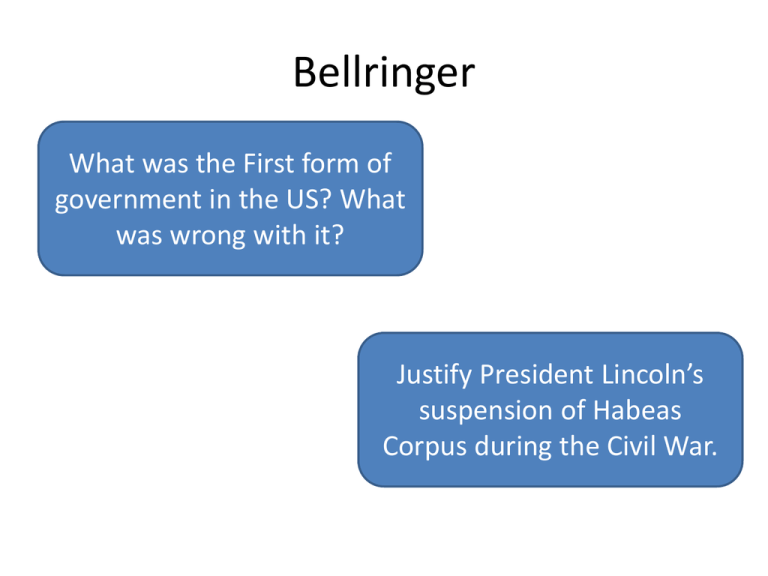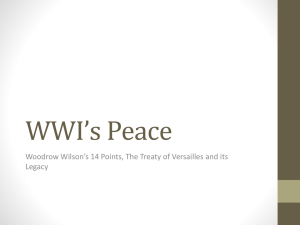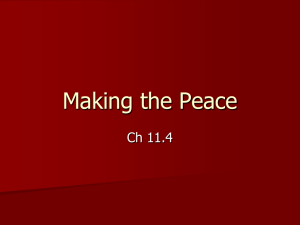World War I - Watertown City School District
advertisement

Bellringer What was the First form of Articles of Confederation. The Feds government were too weakin the US? What was wrong with it? During times of war some Civil Justify President Lincoln’s Liberties are limited. The president suspension of Habeas needed to prevent treason and antiwar sentiments Corpus during the Civil War. Bellringer Congress can make laws that are necessary and proper What is the Elastic Clause? -Freedom of the seas: Lusitania -Safe for democracy: Zimmerman Name 2 reasons the US -Democracy vs. Monarchy: Russians joined temporarily becameWWI a democracy Bellringer Using your Book explain what the following amendments say: 13, 14, 15, 18, 19 What was the US Policy during the early years of WWI? World War I Though the conflict started in Europe, America had become a world power. Soon, even the US could not stay neutral Push for war As the 20th century dawned, the world was ripe for war. Several conditions were steering the world closer and closer: M A I N - Militarism - Alliance System - Imperialism -Nationalism Alliances As tensions increase and fear of war grows, nations sign alliances pledging to protect one another The Triple Alliance Triple Entente Germany Britain AustriaHungary France Italy Russia Powder Keg and Spark The Balkans were known as the Powder Keg of Europe because nationalism between ethnic groups was causing tension. When the Archduke Franz Ferdinand was assassinated the war started. US Neutrality While Europe went to war, America stayed politically neutral. We did not want to get into a costly and deadly war. However, the American public was distinctly divided between the Central Powers and the Allies: Most Americans were 1st or 2nd generation immigrants with ties to their old nations. German Americans and Irish Americans sided with the Germans (Central Powers). The rest of America sided with the British and French, who we felt loyalty to. US peace and Trade Before the War America traded freely with all of Europe. A Naval Blockade stopped trade with Germany, but we still provided Billions to the Allied forces. Preparedness Despite being neutral, many American business leaders urged the US to get ready for war. They promoted preparedness, so the US would be able to aid the Allies if necessary. As a result the Army increased its training and peace time numbers. The Navy also increased its membership and battleship counts. Propaganda Though the US was neutral, images and propaganda posters flooded America. These Propaganda campaigns advertised the war as a civilized Europe against the Germany barbarians. In this poster the Germans are compared to nonevolved apes, with a club to destroy culture and kidnapping women. Freedom of the Seas As the blockade of the North Sea continued, the Germans were getting desperate to cut Britain’s supply route. Using newly developed submarines, known as U-Boats, the Germans announced a War Zone around Britain. Any enemy ships would be attacked. What is the meaning of this newspaper ad? Unrestricted Submarine Warfare The Germans were attacking any ships that flew Allied flags. Despite giving warning, the Germans broke international laws that required all submarines to surface before firing on enemy ships. This violated the US stance that neutral nations have the right to travel and trade during war. Lusitania 1915 German Submarines had a habit of targeting civilian passenger ships. In 1915 they sank the Lusitania, a British passenger ships carrying many American citizens. The USA threatened war but Germany backed down, agreeing to allow civilians a chance to escape. In 1917 German resumed unrestricted submarine warfare Zimmerman Note 1917 After announcing the German U-boats would resume unrestricted submarine warfare, the US uncovered a telegraph from the German foreign secretary, George Zimmerman, to Mexico. In the letter, Germany asked Mexico to attack the US if we joined the war. In return, the Germans would guarantee Mexico reclaim its lost lands in Arizona, new Mexico and Texas. Russian Revolution As the war dragged on into a stalemate, neither side was gaining any advantages. The Russian Revolution overthrew the czar and adopted a democratic government. Now, the war seemed to be democracy vs monarchy. If the US joined it would be in the defense of democracy. War declared During March, 1917, the Germanys sank 5 American ships. By April 6, 1917 the president was signing a Declaration of War, already approved by Congress. Uncle Sam: “Hold the fort, for I am coming!” Mobilizing America Now that war was declared, America needed to mobilize. The Military general recommended the US gather a force of 1 million men by 1918, and an additional 3 million by 1919. The question was, how would the men be gathered? MobilizeGetting troops and supplies ready for war Draft In May 1917 Congress approved the Selective Service Act, a draft to call young men into military service. During the Civil War the Draft had sparked riots and hatred for President Lincoln. During World War I, the war to end all wars, American patriotism was so high, few complained. By 1918, 2 million men had been drafted into the American Expeditionary Force. The Stalemate ends The American troops provided much needed reinforcements for the allies. Soon, the Allies were pushing Germany and the Central powers out of their trenches and back towards Germany. Remember, WWI was a stalemate for much of the war due to Trench Warfare and improved weapon technologies like artillery, machine guns and tanks. Machine gun Gas planes Weapons grenades Tanks Artillery Submarines American Casualties In all, the US lost approximately 51,000 men, far fewer than the millions lost by the Europeans. Thousands more were injured physically and mentally by the war. The War ends On November 11, 1918, the Allies accept an armistice or ceasefire. The guns went silent and the work on a peace treaty finally began. Total War Now that the United States was officially at war, life changed for the Americans. War is costly, in human lives and resources. To ensure there was enough for the war effort the Nation had to become involved in Total War, with all resources going toward the war effort. Total WarAll resources go to the war effort The War at Home: Liberty Bonds To help finance the war, the government sold Liberty Bonds. Bonds can later be redeemed for their original value plus interest. The Liberty Bonds created funds directly for the War effort. In total the Liberty Bonds raised more than $20 Billion. The War at Home: War Departments Industrial factories were converted from consumer good production to military grade supplies. To organize this hundreds of business men and women were hired: -War Industries Board- gave out raw materials, told manufactures what and how much to produce and fixed prices. -War Trade Board- shut down businesses suspected of trading goods to the enemy -War Labor Policies Board set wages, working hours and factory conditions Voluntary Rationing What is the message for each of these The United States, led by President Hoover did not want to establish a rationing system, or price controls on consumer goods. Instead, the US relied on propaganda to get American citizens to cut back. propaganda posters? Daylight Savings Time Daylight Savings Times, turning the clocks ahead by an hour for the summer, helped to save fuel for the war effort. By increasing the amount of hours that work could be done using sunlight, the nation was able to save fuel. Progressive Victory? Thanks to the War, the Government now regulated businesses and even supported Unions. The Unions were able to guarantee certain work hours, wages and safety. Despite some “fixes” the businesses still influenced government decisions, and their profits nearly tripled during the war years. Outbreak of the war US Entry Armistice Women Workers About 16% of male workers joined the military, leaving their jobs vacant. To fill the gap millions of women worked in the factories. Their superb performance during the war in the factories, saving food and reducing consumption eventually earned women the right to vote (19th amendment) Liberty Cabbage With Patriotism at an all time high, many Americans expressed anti-German and anti-immigrant feelings. Calls for quote restricts and anti-German propaganda were everywhere. German books were burned, German was no longer taught in schools and even sauerkraut was renamed “Liberty Cabbage”. Hamburgers became liberty sandwiches. Limited Civil Rights During times of war the government can limit civil liberties and rights to protect the nation!! Espionage Act 1917 To prevent spies and anti-war propaganda, the Espionage Act of 1917 made it illegal to interfere with the draft, sale of Liberty Bonds, and even allowed the Postmaster to bar “treasonous” materials from the mail. Sedition Act of 1918 To further prevent anti-war sentiment, the US made it a crime to speak or publish anything “disloyal, profane, or abusive” about the United States. Together, the Espionage and Sedition Acts sent 1,500 Americans to jail. Eugene Debs A Socialist and former presidential candidate, Debs was sentenced to 10 years in jail for criticizing the American government and business leaders. His work’s message was to resist Militarism. Debs argued the war was simply a fight among imperial capitalists. Schenck v United States Schenck, a member of an anti war group, urged men to avoid the draft and BIG IDEA: war. He was arrested under the Espionage Act for interfering with the draft. Schenck argued v heUS had set the freedom of Speech voice opinions. Schenck the rule thatto Free Speech is not there limits. Ex: You cannot Theabsolute, Supreme Court limited are free speech in time of war, stating that Schenck’s words shout ‘FIRE’ in a crowded theater. presented a “clear and present” danger. falsely Clear and Present Danger… The decision in Schenck v US created the Clear and Present danger doctrine. The Court has the right to prevent words that would cause “ a clear and present danger” Red Scare 1918-1919 In November 1917 a Communist Revolution took place in Russia. The Communist system was hostile to American values and capitalism, and freedoms. By 1918 an intense fear of communism swept America, and communists were sought out for deportation. Red= Communism Red Scare= Fear of Communism Reduced Immigration WWI and the Red Scare continued to increase Nativism. As a result there were far fewer immigrants coming to America, especially from Eastern and Southern Europe. Great Migration WWI accelerated the migration of African Americans to northern cities. A crop failure between 1910 and 1930 pushed many blacks to the north. With immigration nearly stopped due to the war, about 1,500,000 African Americans moved to the industrial north to work in factories. Unfortunately, Racism grew along with African American northern population. 25:50-33: Review The “Clear and Present Danger” ruling in the Supreme Court case Schenck v. United States (1919) confirmed the idea that a. Prayer in public schools is unconstitutional b. Racism in the United States is illegal c. Interstate commerce can be regulated by state governments d. Constitutional rights are not absolute Review From 1914 to 1916, as WWI raged in Europe, Americans were not able to remain neutral in thought as well as action mainly because a. United States membership in military alliances required the nation to fight b. United States newspaper encouraged a policy of imperialist expansion c. The warring powers interfered with the US right to freedom of the seas d. President Woodrow Wilson supported the war aims of Germany and Austria-Hungary Review President Woodrow Wilson’s statement “The world must be made safe for democracy” was made to justify his decision to a. b. c. d. End US imperialism in Latin America Support tariff reform Send troops into Mexico to capture Pancho Villa Ask Congress to declare war against Germany Review What was a major reason for United States entry into World War I? a. To overthrow the czarist government of Russia b. To keep Latin American from being attacked by Germany c. To maintain freedom of the seas d. To break up the colonial empires of the Allies Review “The most stringent protection of free speech would not protect a man in falsely shouting fire in a theater and causing a panic.” -Justice Oliver Wendell Holmes Which interpretation of the Bill of Rights does this statement illustrate? a. The needs of the government are more important than civil liberties b. Constitutional protection of liberty are not absolute c. The Supreme Court can eliminate freedoms listed in the Bill of Rights d. The Bill of Rights does not safeguard individual liberties Review Which situation was the immediate cause of the United States entry into World War I in 1917? a. b. c. d. The league of Nations requested help The Maine was blown up in Havana Harbor Nazi tyranny threatened Western democracy German submarines sank United States merchant ships Peace President Woodrow Wilson played a major role in the European peacemaking process. His proposal was known as the 14 points, which included: -open, not secret, diplomacy -freedom of the seas -arms reduction -Self-determination -“Association of nations” to guarantee diplomacy Self-determination Letting national groups make their own political decisions European negotiations The leaders of Europe had suffered far more than the US and were looking to be repaid for their losses, territorial changes and blame placed on Germany. In the end the Treaty of Versailles demanded the following from Germany: -pay war reparations (repayments) to the allies -Give up its military forces -Cede lands to create Poland and Czechoslovakia -give up overseas colonies Additionally, Germany must accept the blame for starting the war. “Curious, I seem to hear a child weeping. What is the meaning of this cartoon? League of Nations Though the Treaty of Versailles largely ignored the reasonable terms proposed in the Fourteen Points. However, the treaty did set up the League of Nations. The league was meant to solve political disputes diplomatically. Isolationists fears Isolationists in the Senate worried that joining the League of Nations would involve the US in future European wars. When the Senate proposed changes Wilson stubbornly refused. Wilson’s Tour When the senate refused the treaty again and again, Wilson went on a tour to gain public support. He hoped that if the public was on board, they would write to their politicians to approve the Treaty. The trip resulted in huge amounts of stress, leading to a stroke for President Wilson. What’s the problem? Ultimately the US did not sign the Treaty of Versailles so we did not join the League of Nations Washington Naval Conference In 1921, President Warren G. Harding hosted national leaders from Great Britain, France, Italy and Japan to discuss ways to limit arms. Together the nations agreed to set limits on the number of warships each nation could have. They also pledged to keep peace in Asia and protect the independence of China. However, the group failed to establish any means of enforcement. Disarmament Reduction of a nation’s arms an weapons Kellogg Briand Pact As the spirit of peace continued to spread across the world, 15 nations met in Paris in 1928. Together they signed the Kellogg-Briand Pact, which outlawed war, except in self defense. In all 60 nations signed the pact, but enforcement policies weren’t included. Reparations and US Loans Before the war, the United States had been a debtor nation, meaning it owed more money then others owed back. However, during the war the US had been the source of major loans to the European nations. Many European nations struggled to pay back the loans due to reduced trade and rebuilding costs. Dawes Plan To help European nations pay back their loans, the United States lent Germany money so that it could make war reparations to the Allies. In return the Allies would make payments on their war debts. Summation The United States played an integral part during WWI. Despite being neutral the US contributed to the war by providing military supplies to the Allies. After Germany resumed unrestricted Submarine Warfare, the US joined the War to defend Democracy and freedom of the seas. The US troops turned the tide of the war, and earned the US a place at the peace negotiations. In Paris, Woodrow Wilson pushed the Fourteen Points which solved many of the issues that led to WWI. However, the US rejected the treaty because of the League of Nations, fearing it would involve the US in future European wars. Following WWI nations around the world promoted peace, even working together to on the KelloggBriand Pact and Washington Naval Conference.








